Chainsaw lumber cutting is a versatile method for processing wood, emphasizing precision and safety. It allows for efficient cutting and enhances creativity in woodworking projects.
1.1 Overview of Chainsaw Lumber Cutting
Chainsaw lumber cutting involves using a chainsaw to process wood efficiently. It is ideal for milling, ripping, and cross-cutting logs. This method offers precision and flexibility, making it suitable for various woodworking projects. Proper techniques and tools ensure smooth cuts, while guides enhance accuracy. Safety and control are crucial for achieving professional results in lumber cutting tasks.
1.2 Importance of Precision and Safety
Precision in chainsaw lumber cutting ensures clean, accurate cuts, minimizing waste and enhancing the quality of the final product. Safety is critical due to the high-powered nature of chainsaws, with risks of kickback and accidents. Proper techniques and protective gear are essential to prevent injuries. Adhering to safety guidelines protects both the operator and the equipment, while precision ensures efficient and sustainable lumber processing.
Essential Safety Measures
Essential safety measures in chainsaw lumber cutting include proper protective gear, safe cutting techniques, and a well-prepared workspace to minimize risks and ensure efficient operations.
2.1 Personal Protective Equipment (PPE)
Personal Protective Equipment (PPE) is crucial for chainsaw lumber cutting. Essential items include hard hats to protect against falling debris, safety glasses for eye protection, ear protection to prevent hearing damage, gloves for grip and hand safety, steel-toe boots for foot protection, and chainsaw chaps or cut-resistant pants to prevent leg injuries. Wearing PPE minimizes risks and ensures safe lumber cutting operations.
2.2 Chainsaw Safety Features
Modern chainsaws are equipped with essential safety features to minimize risks. A chain brake halts the chain instantly in case of kickback, while anti-vibration systems reduce fatigue. Mufflers lower noise levels, and chain catchers prevent broken chains from whipping back. Many models include throttle locks to avoid accidental acceleration and kickback guards for added protection. These features ensure safer operation and are critical for preventing accidents during lumber cutting tasks.
2.3 Environmental and Workspace Considerations
When cutting lumber, ensure proper ventilation to avoid inhaling sawdust and fumes. Maintain a clean workspace to prevent accidents and reduce waste. Use eco-friendly lubricants and manage sawdust responsibly. Regularly inspect the area for hazards like uneven terrain or loose debris. Adhere to local regulations and practice sustainable logging to minimize environmental impact. A well-organized workspace enhances safety and efficiency, making the cutting process more effective and environmentally friendly.
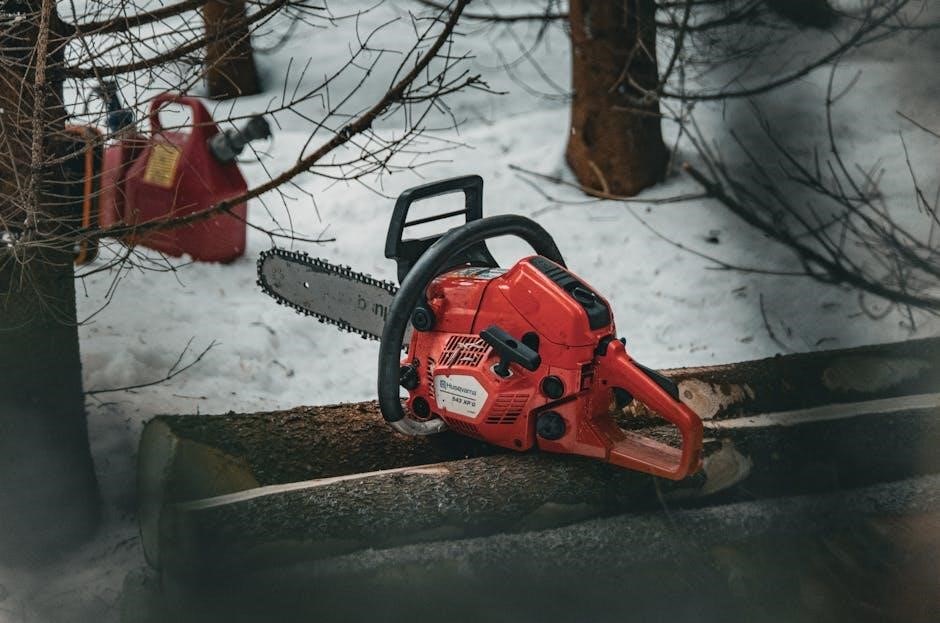
Choosing the Right Chainsaw and Tools
Selecting the right chainsaw involves considering bar length, chain type, and power source. Guide bars and chains vary for cutting efficiency, while accessories like sharpening tools and lubricants ensure optimal performance.
3.1 Selecting the Best Chainsaw for Lumber Cutting
Selecting the best chainsaw for lumber cutting involves considering bar length, chain type, and power source. Gas-powered saws offer high power for large logs, while electric or battery options suit smaller projects. The bar length should match the log diameter, and the chain type must be appropriate for the wood hardness. Guide bars and chain maintenance tools are essential for optimal performance and safety. Choose a saw that balances power, precision, and durability for your specific needs.
3.2 Guide Bars and Chains: Types and Uses
Guide bars and chains are crucial for efficient lumber cutting. Guide bars vary in length and type, with options like standard, low-profile, and laminated bars for durability. Chains range from full-chisel for softwoods to semi-chisel for mixed cutting and carbide-tipped for hardwoods. Proper chain-bar compatibility ensures smooth cuts and prolongs tool life. Regular sharpening and maintenance are essential for optimal performance and safety in various woodworking applications.
3.3 Essential Accessories for Lumber Cutting
Essential accessories for chainsaw lumber cutting include sharpening tools, guide bars, and chains designed for specific tasks. A Timber Tuff cutting guide enhances precision, while workbenches and clamps stabilize lumber. Measuring tools like tape measures and squares ensure accuracy. Sharpening kits maintain chain efficiency, and safety gear like gloves and goggles protect the operator. These accessories improve cutting accuracy, efficiency, and safety, making them indispensable for both professionals and beginners in woodworking projects.
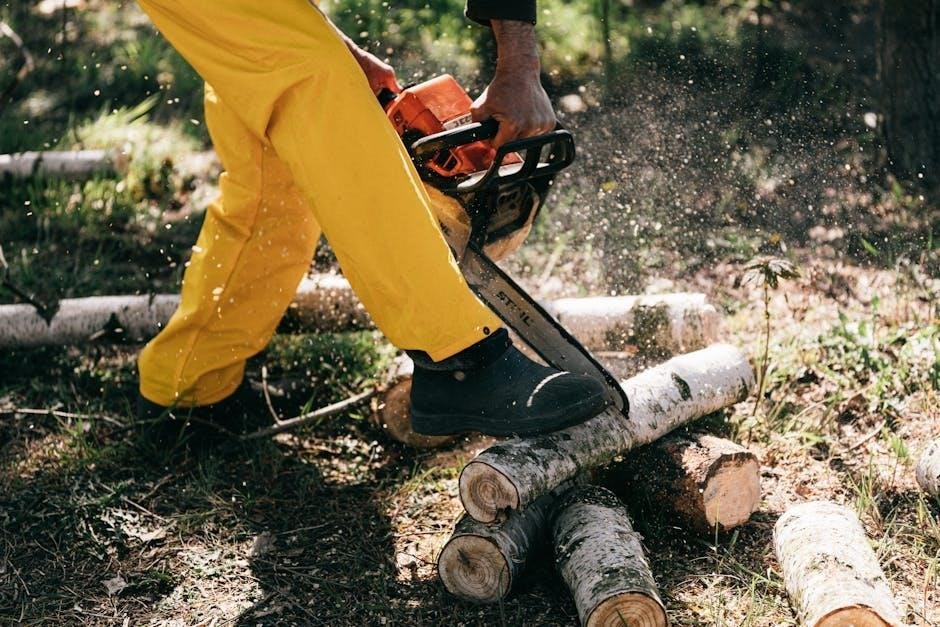
Preparing for the Cut
Preparing for the cut involves measuring, marking, and setting up a stable workspace. Sharpening the chainsaw chain ensures efficiency and safety, while proper planning prevents errors.
4.1 Measuring and Marking Lumber
Accurate measuring and marking are crucial for precise cuts. Use a tape measure and pencil to mark dimensions, ensuring alignment. Double-check measurements to avoid errors. Secure lumber with clamps or a vise for stability. Markings should be clear and visible, guiding the saw for straight cuts. Proper preparation ensures safety and prevents costly mistakes during the cutting process.
4.2 Setting Up the Workspace
Setting up a safe and efficient workspace is essential for successful lumber cutting. Clear the area of debris and obstructions. Secure the lumber on a stable surface or workbench using clamps or straps. Ensure proper lighting to clearly see the cutting line. Maintain a clean workspace to prevent accidents and improve visibility. Proper setup ensures accuracy, safety, and control during the cutting process.
4.3 Sharpening the Chainsaw Chain
Sharpening the chainsaw chain is critical for optimal performance and safety. A dull chain increases the risk of kickback and uneven cuts. Use a file or grinder to sharpen cutters at the correct angle, typically 30-35 degrees. Maintain uniform length to ensure balanced cutting. Regular sharpening improves efficiency, reduces wear, and enhances control. Sharp chains minimize effort and produce smoother cuts, making the cutting process safer and more precise.
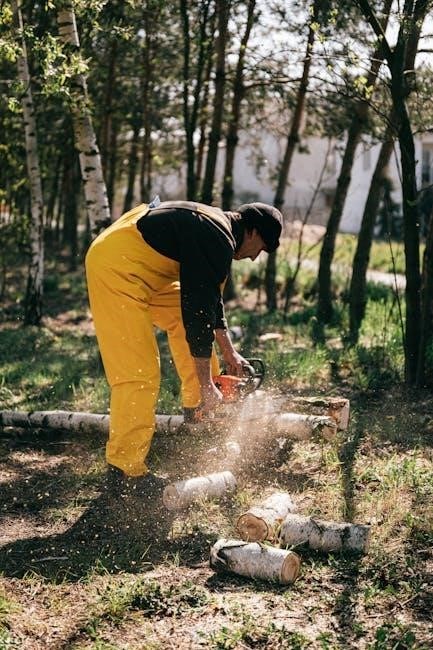
Basic Cutting Techniques
Mastering basic cutting techniques ensures precision and safety. Learn proper stance, grip, and chain control for efficient cross-cutting, ripping, and angled cuts, forming the foundation for advanced methods.
5.1 Cross-Cutting Lumber
Cross-cutting involves slicing lumber perpendicular to its grain, ideal for trimming boards to length. Maintain a firm stance, grip the chainsaw securely, and align the chain with the marked cut. Apply steady, controlled pressure, using the saw’s weight for leverage. Ensure the chain is sharp to prevent uneven cuts. Keep the saw steady and complete the cut smoothly to achieve a clean finish, enhancing efficiency and safety in woodworking projects.
5.2 Ripping Lumber with a Chainsaw
Ripping lumber involves cutting parallel to the wood grain, often used to reduce thickness or create planks. Stand firmly, hold the saw at a slight angle, and guide it steadily along the length of the board. Maintain consistent pressure, allowing the chain to do the work. Keep your hands away from the cutting area and ensure the workspace is clear. Regularly check the chain’s sharpness for smooth, efficient cuts. Safety and control are key to achieving accurate results in ripping lumber efficiently.
5.3 Making Angled Cuts
Making angled cuts with a chainsaw requires precision and control. Adjust the saw to the desired angle, using a guide if needed for accuracy. Mark the wood clearly before cutting. Apply steady, consistent pressure, maintaining a firm grip. Keep hands away from the cutting path and work in a stable environment. Angled cuts are ideal for creating joints or decorative edges. Practice improves precision, ensuring clean and professional results every time.
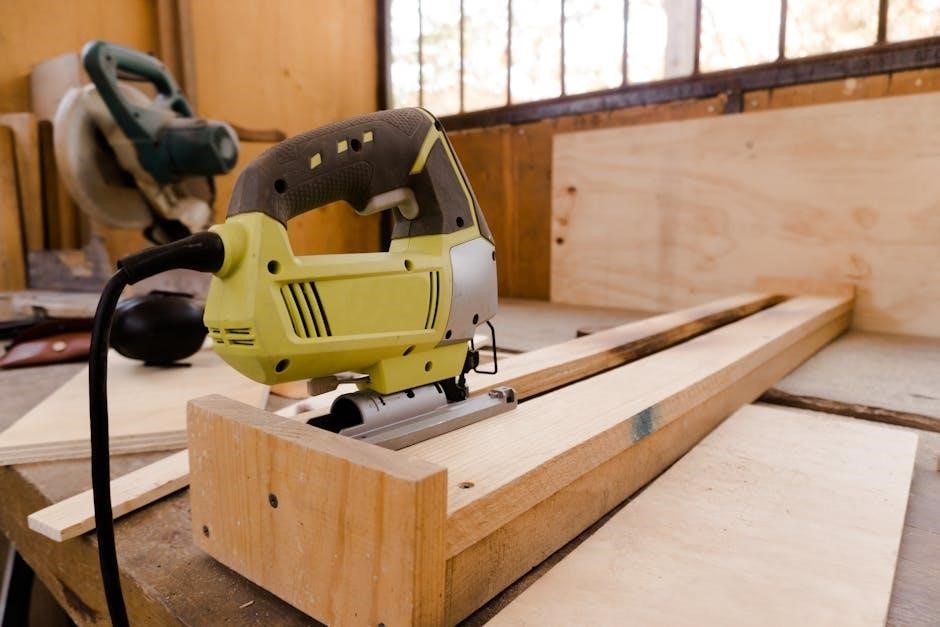
Advanced Cutting Techniques
Advanced techniques involve precise methods like milling, cutting large logs, and achieving smooth finishes. These skills enhance creativity and efficiency in woodworking projects, requiring practice and expertise.
6.1 Milling Lumber with a Chainsaw
Milling lumber with a chainsaw involves converting logs into usable planks or boards. This technique requires a chainsaw mill setup, including a specialized bar and chain, and a stable frame. Proper alignment and consistent pressure ensure smooth cuts. Milling is ideal for processing large or irregularly shaped logs, offering a cost-effective way to produce custom lumber. It’s especially useful for woodworking projects requiring unique sizes or finishes.
6.2 Cutting Large or Hardwood Logs
Cutting large or hardwood logs requires a powerful chainsaw and precise technique. Ensure the saw is equipped with a robust bar and chain designed for heavy-duty cutting. Score the log on both sides to guide the blade and prevent binding. Apply steady, controlled pressure, and use a ripping chain for smoother cuts. Regularly sharpen the chain to maintain efficiency. Always work in a stable, clear workspace and wear proper safety gear when tackling tough logs.
6.4 Achieving Smooth and Precise Cuts
Achieving smooth cuts requires a sharp chain, proper technique, and consistent pressure. Use a high-quality ripping chain for hardwood and maintain optimal chain tension. Guide the saw steadily, avoiding abrupt movements. Employ tools like the Timber Tuff guide for accuracy. Keep the chain well-lubricated to reduce friction. Regularly sharpen the chain and practice control for precise results. Patience and proper maintenance ensure clean, professional-grade cuts every time.
Using Cutting Guides and Tools
Cutting guides and tools enhance accuracy and control. The Timber Tuff Lumber Cutting Guide is popular for precise cuts. Homemade guides and workbenches also aid in achieving professional results.
7.1 Timber Tuff Lumber Cutting Guide
The Timber Tuff Lumber Cutting Guide is a popular tool for achieving precise cuts. Designed to attach to your chainsaw, it helps maintain straight edges and consistent widths. Its sturdy construction ensures durability, while adjustable settings allow for customization. This guide is ideal for ripping lumber evenly and efficiently, making it a valuable asset for both professionals and DIY enthusiasts seeking professional-grade results.
7.2 Homemade Cutting Guides
Homemade cutting guides offer a cost-effective solution for precise chainsaw cuts. Using materials like wood or metal, DIY guides can be crafted to fit specific needs. Clamps or rails attached to the saw ensure straight edges, while makeshift jigs help maintain consistent widths. These customizable tools are ideal for small projects, providing accuracy without specialized equipment, and can be easily adapted for various lumber cutting tasks.
7.3 Role of Workbenches and Clamps
Workbenches and clamps play a crucial role in chainsaw lumber cutting by ensuring stability and safety. A sturdy workbench provides a flat surface for cutting, while clamps securely hold the lumber in place, preventing movement during cuts. This setup enhances precision, reduces the risk of accidents, and allows for better control over the chainsaw, making the cutting process more efficient and accurate.
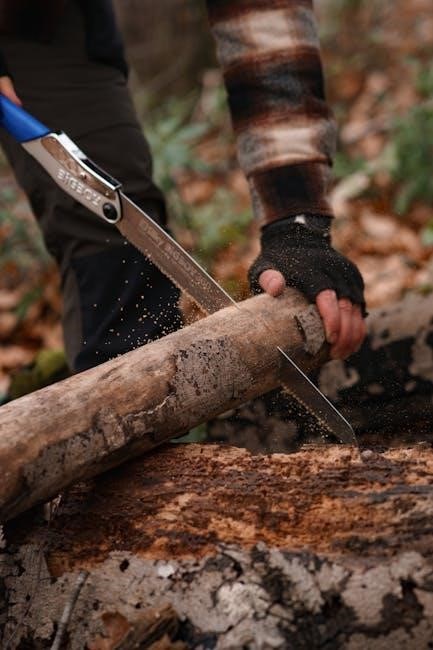
Maintaining Your Chainsaw
Regular chainsaw maintenance is crucial for optimal performance and longevity. It involves cleaning, lubricating, and proper chain care. A consistent routine ensures reliability and safety.
8.1 Cleaning and Lubricating the Chainsaw
Regular cleaning and lubrication are essential for maintaining chainsaw performance. Remove debris from the chain and bar, and clean the air filter to ensure proper airflow. Lubricate the chain and guide bar with the recommended oil to reduce friction and prevent overheating. Proper maintenance extends the life of the saw and ensures smooth, efficient cuts. Consistency in these routines is key to optimal functionality and safety.
8.2 Replacing and Adjusting Chains
Replacing and adjusting chains is crucial for maintaining chainsaw efficiency. Inspect the chain regularly for wear or damage and replace it when necessary. Use the correct tools to tension the chain properly, ensuring it’s neither too loose nor too tight. A well-adjusted chain enhances cutting performance and safety. Always refer to the manufacturer’s guide for specific instructions and recommendations on chain replacement and adjustment techniques.
8.3 Regular Maintenance Schedule
A consistent maintenance schedule ensures optimal chainsaw performance and longevity. Regularly clean the saw, check chain tension, and lubricate moving parts. Sharpen the chain as needed and inspect the guide bar for wear. Schedule annual professional servicing to address complex issues. Adhering to a routine maintenance plan maximizes efficiency, safety, and extends the life of your chainsaw, ensuring it remains reliable for all lumber cutting tasks.

Troubleshooting Common Issues
Identify and address issues like kickback, uneven cuts, or chain dullness promptly. Regular inspection and proper techniques help resolve problems efficiently, ensuring safer and more accurate lumber cutting.
9.1 Dealing with Kickback
Kickback occurs when the chainsaw’s upper bar nose unintentionally contacts wood, causing a violent upward motion. To prevent this, maintain control, avoid cutting small logs, and ensure the chain is sharp. If kickback happens, release the throttle and withdraw the saw. Always wear protective gear and follow proper cutting techniques to minimize risks and ensure safe operation during lumber cutting tasks.
9.2 Managing Uneven or Warped Cuts
Uneven or warped cuts often result from improper technique, uneven logs, or blade alignment issues. To address this, ensure the chainsaw is sharp and well-maintained. Use cutting guides or steady hands to maintain consistent pressure. For warped wood, cut from both sides to achieve symmetry. Regularly inspect the workspace and adjust your approach to avoid unevenness, ensuring smooth and precise cuts in your lumber cutting projects.
9.3 Overcoming Chain Dullness
A dull chainsaw chain reduces cutting efficiency and increases the risk of kickback. Regular sharpening is essential to maintain sharpness. Use files or electric sharpeners to restore the chain’s cutting edges, ensuring proper angle and depth. Inspect the chain frequently for wear and replace it when necessary. Proper storage and lubrication also prevent rust and dullness, ensuring optimal performance during lumber cutting tasks.
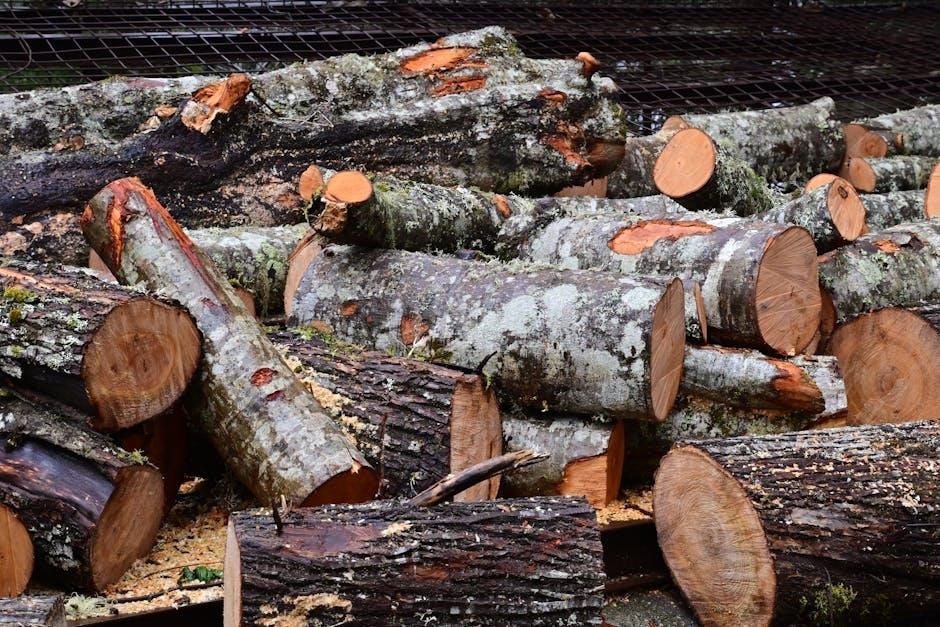
Tips for Beginners
- Start with small, manageable projects to build confidence and skill.
- Practice control and balance to ensure precise cuts and safety.
- Learn from mistakes to refine techniques and improve results.
10.1 Starting with Small Projects
Beginners should start with small, simple projects to build confidence and develop essential skills. Practice cutting smaller logs or boards to master basic techniques. Start with straightforward cuts, such as cross-cutting lumber, before progressing to more complex tasks. This approach helps refine control and balance, ensuring safety and precision. Use a cutting guide if needed and always maintain proper safety gear. Gradually move to larger projects as comfort and proficiency grow.
10.2 Practicing Control and Balance
Mastering control and balance is crucial for effective chainsaw use. Stand firmly with knees slightly bent and grip the saw securely. Practice cutting small logs to build muscle memory and precision. Start with straight cuts to improve stability and gradually tackle angled or curved cuts. Regular practice enhances coordination, reducing fatigue and improving accuracy. Always maintain a safe stance and keep the chainsaw close to your body for better control.
10.3 Learning from Mistakes
Learning from mistakes is essential for improving chainsaw lumber cutting skills. Analyze errors to identify root causes, such as improper technique or equipment issues. Adjust your approach based on feedback and practice consistently. Overcoming setbacks builds confidence and refines your craftsmanship. Embrace mistakes as opportunities to grow, ensuring safer and more precise cuts over time.
Chainsaw lumber cutting combines skill, safety, and creativity. By mastering techniques and maintaining equipment, you can achieve professional results. Keep practicing and refining your craft for optimal outcomes.
11.1 Summary of Key Points
Chainsaw lumber cutting requires precision, safety, and the right tools. Essential steps include proper equipment selection, workspace setup, and sharpening. Techniques like cross-cutting and ripping ensure accuracy. Using guides enhances results, while regular maintenance prolongs tool life. Safety remains paramount, with PPE and awareness critical. Practice and patience refine skills, leading to professional-grade outcomes in woodworking projects.
11.2 Final Safety Reminders
Always wear PPE, including gloves, safety glasses, and a helmet. Maintain a safe distance from bystanders and ensure the workspace is clear of hazards. Regularly inspect and maintain your chainsaw to prevent malfunctions. Never cut wood when fatigued or uncertain. Keep the chain sharp and properly tensioned to avoid kickback. Stay focused and follow safety guidelines to ensure a secure cutting environment.
11.3 Encouragement for Further Practice
Consistently practicing chainsaw lumber cutting will refine your skills and build confidence. Embrace challenges and experiment with new techniques to enhance your craftsmanship. Celebrate small victories and recognize progress, as mastery takes time. Stay patient, apply safety habits, and enjoy the journey of creating something meaningful with your own hands. Each project is an opportunity to learn and grow, fostering a deeper connection with woodworking.
Additional Resources
Explore recommended tools, online tutorials, and books for advanced chainsaw techniques. These resources offer detailed guides and expert tips to enhance your lumber cutting skills.
12.1 Recommended Tools and Guides
For efficient lumber cutting, consider the Timber Tuff Lumber Cutting Guide, chainsaw mills, and ripping bars. Tools like the Husqvarna X-Cut chain enhance precision. Online tutorials on YouTube and books by woodworking experts provide comprehensive guidance, ensuring optimal results and safety in your projects.
12.2 Online Tutorials and Videos
YouTube channels like “Chainsaw Milling” and “Woodworking Adventures” offer detailed tutorials on chainsaw techniques. Videos cover topics such as cross-cutting, ripping, and angled cuts, providing step-by-step instructions. These resources are invaluable for both beginners and experienced users, ensuring safe and precise cuts.
12.3 Books on Chainsaw Lumber Cutting
Books like “The Chainsaw Manual” and “Chainsaw Lumber Making” provide comprehensive guides for chainsaw techniques. These resources detail safety practices, cutting methods, and project ideas, catering to both novices and experienced woodworkers. They offer in-depth insights into optimizing chainsaw use for precise and efficient lumber cutting, making them valuable additions to any woodworking library.


